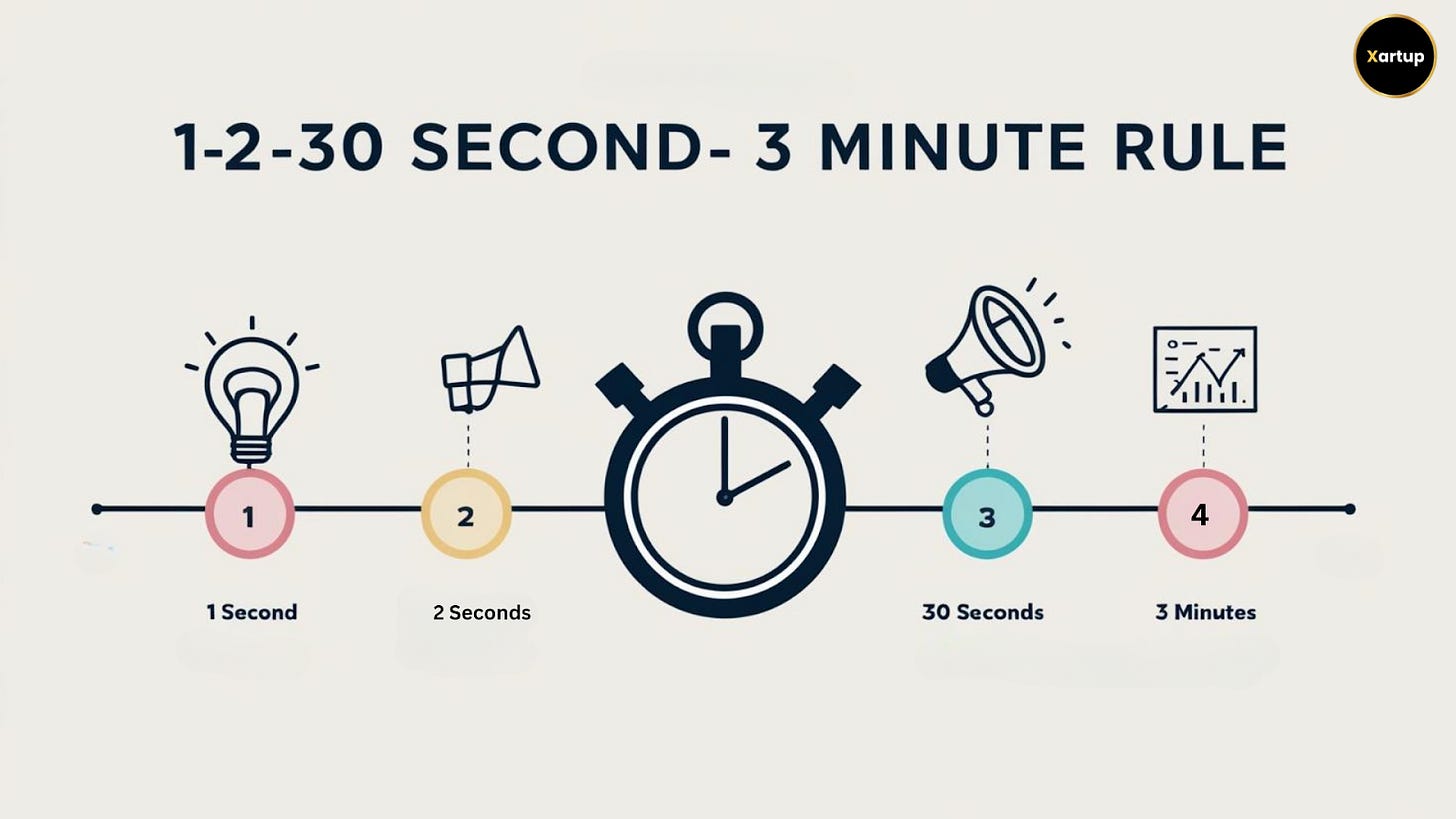Craft a Winning Pitch Deck from an Investor's Perspective
A step-by-step playbook on how to make your pitch deck irresistible (or at least tolerable) to investors.
🧠 Ever wondered what investors actually think when they’re flipping through your pitch deck?
Your pitch deck isn’t just a summary of your business—it’s your ticket to funding. But with countless startups vying for capital, investors are skimming decks faster than you can say "valuation."
So, what catches their eye? What makes them stay? And what sends your deck straight to the “no” pile? In this newsletter, we break down how investors evaluate pitch decks, what they’re looking for, and how to make yours stand out.
How Investors Really Review Your Pitch Deck
Let’s be real: Investors are busy people with attention spans that rival goldfish. When they open your pitch deck, the clock is ticking. The stats?
This is where the 1-2-30 Second-3 Minute Rule comes in—a framework that can make or break your pitch deck.
1 Second: First Impressions Matter
Investors glance at your pitch deck to judge its design, readability, and professionalism. If it looks cluttered or poorly formatted, they’ll move on without reading further.2 Seconds: The Hook
Investors read the headline or tagline. It needs to grab attention and clearly communicate your startup’s unique value.30 Seconds: Skim and Assess
At this stage, they quickly scan the deck for major points: problem, solution, market size, and traction. They’re looking for standout metrics, a clear narrative, and potential for growth.3 Minutes: Full Review
If you’ve passed the first three filters, investors will spend time diving deeper into your deck. They’ll analyze the finer details, such as your financials, team, and defensibility.
So how do you make it past the dreaded 3-second test? Let’s break it down with some humor and hard truths.
Step 1: Your Cover Slide is Like a Dating Profile
First impressions matter, folks. Your cover slide is your one-line pick-up line for investors. If it’s vague, boring, or reeks of fluff, expect a hard pass.
Bad Example: “Disrupting the $1T banking industry with revolutionary AI.”
Good Example: “Helping small businesses get paid 5x faster.”
Keep it clean, professional, and focused on the problem you’re solving.
Step 2: Problem Slides That Scream “PAY ATTENTION”
Investors have seen it all. “Banking is broken”? Yawn. But tell them 40 million small businesses wait 47 days for payments, losing $4.5 trillion annually? Now you’ve got their ears.
Be specific.
Show the size and impact of the problem.
Make it impossible for them to ignore.
Step 3: Solutions That Are Believable (No Magic Wands)
Match your solution directly to the problem. If your “solution” sounds like you pulled it out of a sci-fi novel, it’s a no-go.
Bad Example: “AI-powered revolutionary platform.”
Good Example: “Automated payment collection that reduces wait time from 47 to 7 days.”
Logic and clarity > hyperbole.
If you're building a business, apply to the Xartup Fellowship Program and join a thriving community of 2,500+ founders tackling one of the toughest times in the Indian startup ecosystem.
The Xartup Fellowship has been an incredible journey for its fellows:
2,500+ Alumni
300+ Startups
$5M+ in Funding Raised by Alumni
Be part of this transformative network driving success in the startup world.
Step 4: Market Sizes That Make Sense
Yes, investors like big markets. But they love realistic math even more. Show them your homework:
Bad Example: “TAM: $1T global market.”
Good Example: “40M users × $100/month = $48B serviceable market.”
Bottom-up calculations are your friend.
Step 5: Avoid the Instant Deal Killers
Here’s what makes investors close your deck faster than you can say “pivot:”
Unclear problem statements.
Walls of text.
Marketing jargon and fluff.
Hyperbolic claims ("world-changing" is a red flag).
Bullet points that outnumber a novel.
Step 6: The Team Slide—Who Really Matters?
Investors care about the people behind the vision. Show only key players who:
Are full-time.
Have relevant domain expertise.
Hold significant equity (>10%).
Two co-founders with domain expertise > 20 part-time advisors.
Step 7: Traction and Numbers That Matter
Early-stage? Investors don’t need 5-year projections. Focus on:
Current traction.
Unit economics.
Monthly growth rates.
10% week-over-week growth > Hockey-stick revenue graphs.
Step 8: The Money Ask—Make It Clear
Don’t beat around the bush. Use this formula: “Raising [X] to achieve [Y] in [Z] timeframe.”
Example: “Raising $500K to reach $100K MRR in 9 months.”
No “18 months runway” nonsense.
Resources to Craft Your Pitch Deck
📘 "Pitch Anything" by Oren Klaff – A deep dive into structuring persuasive pitches.
🎥 Ultimate Pitch Deck Template Blueprint
Conclusion
Creating a pitch deck isn’t about dazzling investors with flashy slides—it’s about telling a compelling, data-backed story. By focusing on clarity, conciseness, and key metrics, you can ensure your pitch deck gets the attention it deserves.
👉 Ready to refine your pitch? Let us know what aspect of your pitch deck you need help with—we’re here to guide you every step of the way!
If you are building a business, apply to Xartup Fellowship Program where we have a thriving community of 2,400+ founders navigating through one of the toughest time in the Indian startup ecosystem.
It’s been an amazing journey for the Xartup Fellowship Program Fellows
2400+ Alumni
300+ Startups
$9M+ in funding raised by Alumni







